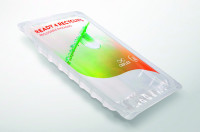Already for the 54th time, the members of the Chocolate Technology Working Group of the Industrial Association for Food Technology and Packaging (IVLV) met. Also in this year, the wide range of topics allowed the participants to see the bigger picture beyond chocolate. Besides fat bloom development, the use of spices and nuts was paramount to the event.
With more than 120 participants, the traditional IVLV meeting “chocolate technology” finally became too big for the previous venue in the rooms of the Fraunhofer Institute for Process Engineering and Packaging (IVV) in Frei-sing/Germany. Therefore, it moved to the Lindenkeller in Freising for the first time, where a successful premiere took place.
Besides the warhorse fat bloom, aroma was on the agenda of this year’s meeting. On the one hand, the pure chocolate aroma and its release were subject of discussion, and on the other hand, interesting taste sensations caused by additions was a topic. Aroma research is currently under-going change. For decades, scientists were searching for key flavours, those substances among the many volatiles which are responsible for the characteristic taste of a food. Today, the focus on the so-called Flavour Release is increasing, which describes the release of volatiles when the food is consumed, and what makes them sensory available.
In a lively lecture, Dr Eva Ortner (Fraunhofer IVV) introduced the participants into the world of Flavour Release and the complexity of flavour perception in food. During chewing and swallowing, released flavour volatiles are perceived in a retronasal manner by a breath blow. For example, the sucking of gummy bears only causes a weak aroma impression in contrast to intense chewing, since only here the flavours are released. Additionally, leftover aromas remain in the mouth for a pleasant aftertaste that lasts up to half an hour after espresso consumption.
At the IVV, research work on the Flavour Release is also carried out in vivo, with the direct detection of the aroma substances in the breathing air and the identification with PTR-MS. The analysis of flavour release of chocolate is not only hardened by the already considerably high amount of aroma compounds, but also by the complex matrix of the product. However, in the following lecture, Dr Gottfried Ziegleder (formerly Fraunhofer IVV) demonstrated how technology influences the flavour release of chocolates.
The focus of chocolate production is grinding and conching. It is only during intensive conching that the harmonious taste of the chocolates develops from “cocoa plus sugar” to “chocolate”. Several effects contribute to this. The flow behaviour of the conched chocolate mass is smoother and allows a more intense mouthfeel. The diverse flavours, which were initially included in cocoa particles and dissolved in cocoa butter, are redistributed in the mass. They are increasingly coating the sugar surfaces. As a result, they become more available for sensory perception and provide a long lasting aroma impression over a few minutes. After conching, is not possible anymore to distinguish the taste of sugar and cocoa because both types of particles are carrying cocoa flavour, which results in a holistic taste.
The technological challenge is to optimise the energy input in the conche in order to make the process economical. In cooperation with industrial companies, the Fraunhofer IVV developed valuable insights and put them into practice. The two presentations on Flavour Release made clear how the institute’s technological developments and state-of-the-art flavour research complement each other.
Besides the chocolate aroma itself, more frequently very small amounts of additions such as spices, aromas and colours are used to create an interesting flavour. This provides manifold possibilities, but also risks. In the opening lecture, Dr Ute Weisz (Fraunhofer IVV) reported about conventional spice processing and some alternatives.
Conventional spice processing is remarkably similar to cocoa production in the countries of origin: the raw product is sun dried after harvesting, on rare occasions solar drying is used, and subsequently the products are transported, ground, sterilized and packed for further use. Especially the slow sun drying with partial rehydration during the night promotes mould growth and augmentation of pathogens.
Salmonella is another hot topic in spices. Especially food which is not heated is subject to salmonella affection. This is also true for chocolate and its additions. A remedy is the use of alternative processing for spices in which the spices are blanched and milled before the drying step. Additionally, different sterilisation processes can be used, as reported by Dr Peter Muranyi (Fraunhofer IVV). He also mentioned the increased stability of microorganisms, which were subject to stress such as thermal shocks, or wrong negative colony count caused by antimicrobial substances such as phenols or essential oils in the product.
For some sterilisation processes such as radiation using Xenon-pulsed light, the special surface of spices has to be taken into account. It is often porous or rough, and the effectivity of sterilisation can be reduced. Besides spices, other chocolate additions are affected, such as nuts. As a specialty, the almond pasteurisation in USA has to be mentioned, which was reported by Anett Winkler (Cargill). However, the food safety plan is also relevant for other food and is often carried out by using validated process controls.
The addition of spices is not limited to microbiological challenges, but, considering the small amounts, the processing is also complex. This topic was presented by Isabell Rothkopf (Fraunhofer IVV). She introduced the upcoming project about homogeneous mixing of small amounts into chocolate and the resulting difficulties.
Until now, additions such as spices, flavours and colours are added at the beginning of the process to achieve a homogeneous distribution. In the case of a product change, the cleaning effort is extremely high, and with some products, for example for allergens, it is insufficient. Thus, the addition should be carried out in the process as late as possible. The upcoming difficulties are caused by the limited space, the thermal energy input, which affects tempering, as well as the altered flow behaviour. This highly interdisciplinary project raises a lot of questions and, at the same time, promises exciting reports for the following meetings.














































